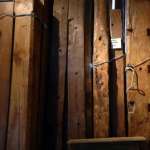Guest post by Liza Hanks of Winchcombe Reclamation, specialists in promoting and facilitating the use of reclaimed building materials and working with all types of demolition and construction projects to divert materials from landfill.
 Why use reclaimed building products? Lots of people can answer this very simply… because they have to, planning constraints, listed buildings and areas of outstanding natural beauty and conservation area all add up to a definitive legal requirement for many people to match any new building work to an existing one.
Why use reclaimed building products? Lots of people can answer this very simply… because they have to, planning constraints, listed buildings and areas of outstanding natural beauty and conservation area all add up to a definitive legal requirement for many people to match any new building work to an existing one.
But this I feel misses the point, and here’s why.
1. Hold a handmade clay tile in one hand and a machine made one in the other. One hand is scratched by the precise rough edges and the other almost feels the warmth of the craftsman who held the tile 200 years ago as he pressed his thumb into a piece of clay on the back to form the nib. Preserving our building heritage and it component parts allows us to touch our social history and keep it alive. Many geographical areas will have their own particular methods of construction. For example in the Cotswolds where we have our honey on toast coloured stone. Its availability has sculpted the landscape, and its structural strengths and weaknesses defined its use. Experienced local builders will only pick up and hold a stone once before its position is decided, an experienced bricklayer trained in producing a similar end result, a sturdy wall, will fight to find the right place for the same stone. In reusing the material we are also reusing the skills and keeping them alive.
2. But its not just in old buildings where there is a need for reclaimed materials, we keep seeing examples of reclaimed materials being used in modern exciting buildings. Where these are used, the material, be it bricks, beams, floorboards or fireplaces really sing out. Their warmth, texture and familiarity adds depth and personality to a room. The very nature of reclaiming building materials is at it core, recycling, reducing the amount ending up in landfill.
3. Using reclaimed materials lowers a building’s carbon footprint. Traditional methods of construction used materials locally available. They would have been mainly hand produced using physical labour instead of mechanical energy sources. Reclaiming materials is a labour intensive process and chemicals are not readily used to clean or restore. New building materials are less likely to be produced in the west but are readily produced in developing countries by companies who may not enquire about working wages or conditions. They also need to be transported, which further increases their carbon footprint.